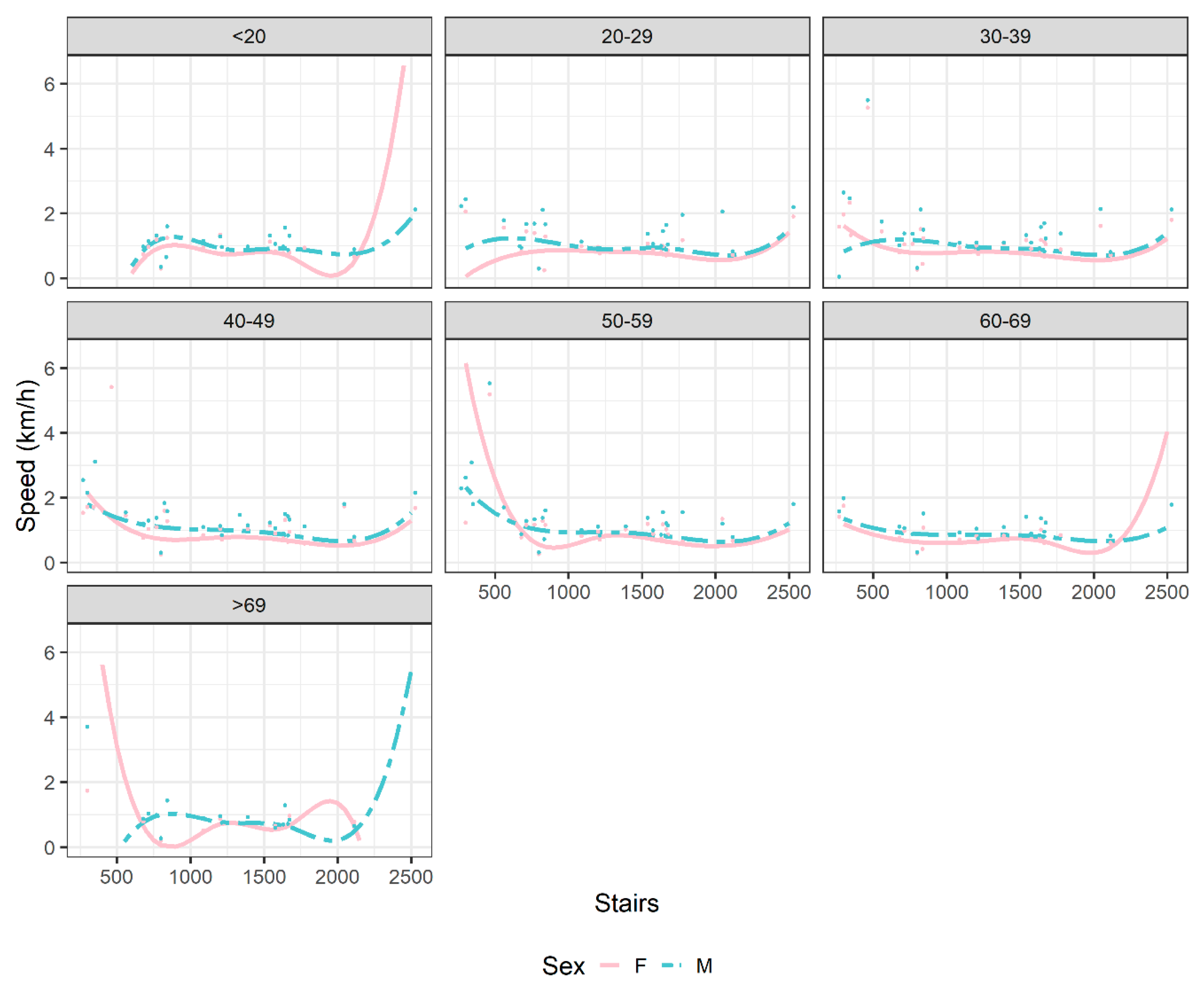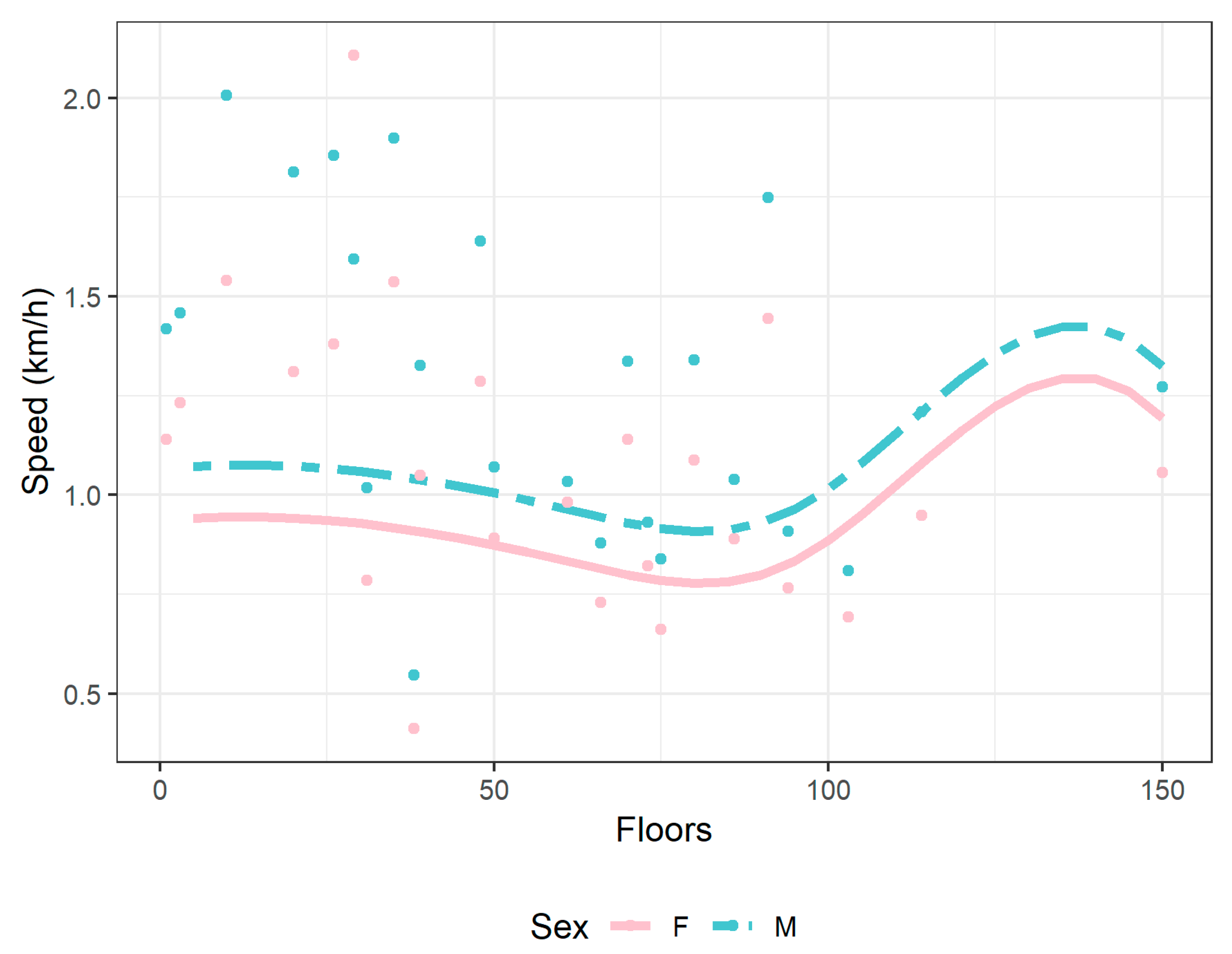Tower Running—Participation, Performance Trends, and Sex Difference
Abstract
1. Introduction
2. Materials and Methods
2.1. Ethics Approval
2.2. Methodology
2.3. Statistical Analysis
3. Results
4. Discussion
4.1. Change in the Men-to-Women Ratio Across Years
4.2. Sex Difference in Performance
5. Conclusions
Supplementary Materials
Author Contributions
Funding
Conflicts of Interest
References
- Deaner, R.O.; Addona, V.; Carter, R.E.; Joyner, M.J.; Hunter, S.K. Fast men slow more than fast women in a 10 km road race. PeerJ 2016, 2016. [Google Scholar] [CrossRef]
- Cuk, I.; Nikolaidis, P.T.; Markovic, S.; Knechtle, B. Age differences in pacing in endurance running: Comparison between marathon and half-marathonMen and Women. Medicina 2019, 55, 479. [Google Scholar] [CrossRef]
- Knechtle, B.; Nikolaidis, P.T. Sex- and age-related differences in half-marathon performance and competitiveness in the world’s largest half-marathon-the GöteborgsVarvet. Res. Sports Med. 2018, 26, 75–85. [Google Scholar] [CrossRef]
- Vitti, A.; Nikolaidis, P.T.; Villiger, E.; Onywera, V.; Knechtle, B. The “New York City Marathon”: Participation and performance trends of 1.2M runners during half-century. Res. Sports Med. 2019. [Google Scholar] [CrossRef]
- Nikolaidis, P.T.; Knechtle, B. Russians are the fastest and the youngest in the “Comrades Marathon”. J. Sports Sci. 2019, 37, 1387–1392. [Google Scholar] [CrossRef]
- Knechtle, B.; Valeri, F.; Zingg, M.A.; Rosemann, T.; Rüst, C.A. What is the age for the fastest ultra-marathon performance in time-limited races from 6 h to 10 days? Age 2014, 36. [Google Scholar] [CrossRef] [PubMed]
- Knechtle, B.; Nikolaidis, P.T.; Di Gangi, S. World single age records in running from 5 km to marathon. Front. Psychol. 2018, 9. [Google Scholar] [CrossRef] [PubMed]
- Senefeld, J.; Smith, C.; Hunter, S.K. Sex differences in participation, performance, and age of ultramarathon runners. Int. J. Sports Physiol. Perform. 2016, 11, 635–642. [Google Scholar] [CrossRef] [PubMed]
- Waldvogel, K.J.; Nikolaidis, P.T.; Di Gangi, S.; Rosemann, T.; Knechtle, B. Women reduce the performance difference to men with increasing age in ultra-marathon running. Int. J. Environ. Res. Public Health 2019, 16, 2377. [Google Scholar] [CrossRef]
- Jenkins, E.M.; Nairn, L.N.; Skelly, L.E.; Little, J.P.; Gibala, M.J. Do stair climbing exercise “snacks” improve cardiorespiratory fitness? Appl. Physiol. Nutr. Metab. 2019, 44, 681–684. [Google Scholar] [CrossRef]
- Hongu, N.; Shimada, M.; Miyake, R.; Nakajima, Y.; Nakajima, I.; Yoshitake, Y. Promoting Stair Climbing as an Exercise Routine among Healthy Older Adults Attending a Community-Based Physical Activity Program. Sports 2019, 7, 23. [Google Scholar] [CrossRef] [PubMed]
- Honda, H.; Igaki, M.; Hatanaka, Y.; Komatsu, M.; Tanaka, S.; Miki, T.; Suzuki, T.; Takaishi, T.; Hayashi, T. Stair climbing/descending exercise for a short time decreases blood glucose levels after a meal in people with type 2 diabetes. BMJ Open Diabetes Res. Care 2016, 4, e000232. [Google Scholar] [CrossRef] [PubMed]
- Donath, L.; Faude, O.; Roth, R.; Zahner, L. Effects of stair-climbing on balance, gait, strength, resting heart rate, and submaximal endurance in healthy seniors. Scand. J. Med. Sci. Sports 2014, 24, e93–e101. [Google Scholar] [CrossRef] [PubMed]
- Romancuk, N.; Nikolaidis, P.T.; Villiger, E.; Chtourou, H.; Rosemann, T.; Knechtle, B. Performance and Participation in the ‘Vasaloppet’ Cross-Country Skiing Race during a Century. Sports 2019, 7, 86. [Google Scholar] [CrossRef] [PubMed]
- Nikolaidis, P.T.; Villiger, E.; Knechtle, B. Participation and Performance Trends in the ITU Duathlon World Championship From 2003 to 2017. J. Strength Cond. Res. 2018. [Google Scholar] [CrossRef]
- Legato, M.J. Gender and the heart: Sex-specific differences in normal anatomy and physiology. J. Gend. Specif. Med. JGSM Off. J. Partnersh. Women’s Health Columbia 2000, 3, 15–18. [Google Scholar]
- Nindl, B.C.; Sharp, M.A.; Mello, R.P.; Rice, V.J.; Murphy, M.M.; Patton, J.F. Gender comparison of peak oxygen uptake: Repetitive box lifting versus treadmill running. Eur. J. Appl. Physiol. Occup. Physiol. 1998, 77, 112–117. [Google Scholar] [CrossRef]
- Knechtle, B.; Nikolaidis, P.T.; König, S.; Rosemann, T.; Rüst, C.A. Performance trends in master freestyle swimmers aged 25–89 years at the FINA World Championships from 1986 to 2014. Age 2016, 38, 1–8. [Google Scholar] [CrossRef]
- Wright, A.; Marino, F.E.; Kay, D.; Micalos, P.; Fanning, C.; Cannon, J.; Noakes, T.D. Influence of lean body mass on performance differences of male and female distance runners in warm, humid environments. Am. J. Phys. Anthropol. 2002, 118, 285–291. [Google Scholar] [CrossRef]
- Lewis, D.A.; Kamon, E.; Hodgson, J.L. Physiological Differences Between Genders Implications for Sports Conditioning. Sports Med. 1986, 3, 357–369. [Google Scholar] [CrossRef]
- O’Loughlin, E.; Nikolaidis, P.T.; Rosemann, T.; Knechtle, B. Different predictor variables for women and men in ultra-marathon running—the wellington urban ultramarathon 2018. Int. J. Environ. Res. Public Health 2019, 16, 1844. [Google Scholar] [CrossRef]
- Nikolaidis, P.T.; Chalabaev, A.; Rosemann, T.; Knechtle, B. Motivation in the athens classic marathon: The role of sex, age, and performance level in Greek recreational marathon runners. Int. J. Environ. Res. Public Health 2019, 16, 2549. [Google Scholar] [CrossRef] [PubMed]
- Waśkiewicz, Z.; Nikolaidis, P.T.; Gerasimuk, D.; Borysiuk, Z.; Rosemann, T.; Knechtle, B. What motivates successful marathon runners? The role of sex, age, education and training experience in Polish runners. Front. Psychol. 2019, 10. [Google Scholar] [CrossRef] [PubMed]



| Building | City | Steps | Data Available (Years) | Included (Years) |
|---|---|---|---|---|
| Millennium Tower | Wien | 2529 | 2014–2016 | 2014–2016 |
| Willis Tower (Sears Tower until 2009) | Chicago | 2109 | 2014–2019 | 2018 |
| Taipei 101 | Taipeh | 2046 | 2014–2019 | 2017–2018 |
| CN Tower | Toronto | 1776 | 2014–2019 | 2017–2018 |
| Reunion Tower | Dallas | 1674 | 2018–2019 | 2018 |
| Eiffelturm | Paris | 1665 | 2015–2020 | 2015–2018 |
| AON Center | Chicago | 1643 | none on towerrunning.com | 2018 |
| John Hancock Center (875 North Michigan Avenue) | Chicago | 1632 | 2014–2019 | 2017–2018 |
| Empire State Building | New York | 1576 | 2014–2019 | 2017–2014 |
| Bank of America Plaza | Dallas | 1540 | none on towerrunning.com | 2018 |
| US Bank Tower | Los Angeles | 1500 | 2014–2019 | 2018 |
| thyssenkrupp Testturm | Rottweil | 1390 | 2018–2019 | 2018 |
| Swissôtel The Stamford | Singapur | 1336 | 2014–2018 | 2017 |
| Rockefeller Center | New York City | 1214 | 2014–2016, 2018, 2019 | 2019 |
| MesseTurm | Frankfurt am Main | 1202 | 2014–2019 | 2014–2017 |
| Three Logan Square | Philadelphia | 1088 | 2014–2019 | 2014, 2018, 2019 |
| Valliance Bank | Oklahoma City | 837 | 2014–2019 | 2019 |
| Holmenkollbakken | Oslo | 800 | 2015–2018 | 2015–2017 |
| Run Up Berlin (Park Inn Hotel) | Berlin | 770 | 2015–2019 | 2015–2018 |
| KölnTurm | Köln | 714 | none on towerrunning.com | 2016–2019 |
| Oakbrook Terrace Tower | Oakbrook | 680 | 2014–2020 | 2019 |
| Münsterturm | Ulm | 560 | none on towerrunning.com | 2014–2018 |
| Towerrun | Berlin | 465 | 2014–2020 | 2018 |
| St.George’s Tower | Leicester | 351 | none on towerrunning.com | 2018 |
| Matzleinsdorfer Hochhaus | Wien | 342 | 2017 | 2017 |
| Windradlauf | Lichtenegg | 300 | 2014 | 2014 |
| Haus des Meeres | Wien | 271 | 2015–2019 | 2016–2018 |
| Oluempia Hotel | Tallinn | N/A | 2015–2019 | 2017 |
| Age Group | Sex | N | Mean (SD) | p | Men-to-Women Ratio |
|---|---|---|---|---|---|
| <20 | F | 501 | 0.73 (0.27) | <0.001 | 1.30 |
| M | 652 | 0.91 (0.38) | |||
| 20–29 | F | 1887 | 0.81 (0.24) | <0.001 | 1.39 |
| M | 2615 | 0.99 (0.35) | |||
| 30–39 | F | 2552 | 0.80 (0.30) | <0.001 | 1.34 |
| M | 3415 | 1.03 (0.39) | |||
| 40–49 | F | 1941 | 0.78 (0.32) | <0.001 | 1.33 |
| M | 2583 | 1.00 (0.39) | |||
| 50–59 | F | 1220 | 0.76 (0.30) | <0.001 | 1.60 |
| M | 1951 | 0.97 (0.38) | |||
| 60–69 | F | 239 | 0.72 (0.25) | <0.001 | 2.62 |
| M | 626 | 0.90 (0.27) | |||
| >69 | F | 44 | 0.66 (0.33) | 0.003 | 4.57 |
| M | 201 | 0.83 (0.33) |
| Females (n = 11,886) | Males (n = 16,270) | p-Value | |
|---|---|---|---|
| Speed km/h | 0.85 (0.37) | 1.06 (0.46) | <0.001 |
| Time (min) | 24.26 (14.16) | 18.43 (11.69) | <0.001 |
| Tower height (m) | 296.25 (111.37) | 276.27 (108.72) | <0.001 |
| Floors | 85.44 (36.37) | 76.00 (35.97) | <0.001 |
| Stairs | 1466.43 (420.36) | 1401.18 (429.59) | <0.001 |
© 2020 by the authors. Licensee MDPI, Basel, Switzerland. This article is an open access article distributed under the terms and conditions of the Creative Commons Attribution (CC BY) license (http://creativecommons.org/licenses/by/4.0/).
Share and Cite
Stark, D.; Di Gangi, S.; Sousa, C.V.; Nikolaidis, P.; Knechtle, B. Tower Running—Participation, Performance Trends, and Sex Difference. Int. J. Environ. Res. Public Health 2020, 17, 1902. https://doi.org/10.3390/ijerph17061902
Stark D, Di Gangi S, Sousa CV, Nikolaidis P, Knechtle B. Tower Running—Participation, Performance Trends, and Sex Difference. International Journal of Environmental Research and Public Health. 2020; 17(6):1902. https://doi.org/10.3390/ijerph17061902
Chicago/Turabian StyleStark, Daniel, Stefania Di Gangi, Caio Victor Sousa, Pantelis Nikolaidis, and Beat Knechtle. 2020. "Tower Running—Participation, Performance Trends, and Sex Difference" International Journal of Environmental Research and Public Health 17, no. 6: 1902. https://doi.org/10.3390/ijerph17061902
APA StyleStark, D., Di Gangi, S., Sousa, C. V., Nikolaidis, P., & Knechtle, B. (2020). Tower Running—Participation, Performance Trends, and Sex Difference. International Journal of Environmental Research and Public Health, 17(6), 1902. https://doi.org/10.3390/ijerph17061902








